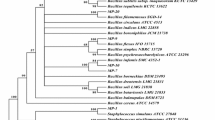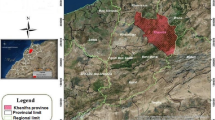Abstract
Despite the extensive agricultural use of municipal solid waste (MSW) compost, there is little information about microbial characteristics of the MSW compost and fate of microorganisms following land application. This study was designed to determine the microbial quality and germination index (GI) of the MSW compost as well as fate of indicator microorganisms after application of MSW compost. The results showed a high fraction of samples are immature (GI < 80). In 27% and 16% of samples fecal coliforms and Salmonella were detected in a range exceeding the recommended value for unrestricted application of compost, respectively. HAdV was also detected in 62% of samples. Fecal enterococci were detected with relatively high concentrations in all samples and showed higher survival rate than other indicators in land-applied MSW compost. The results showed that climate condition significantly contributed to the decline of indicator bacteria in land-applied compost. The results highlight the need for further quality monitoring of compost to ensure that its application does not lead to environmental or human health problems. Furthermore, because of the high concentrations and high survival rate of enterococci in compost samples, they can be specifically proposed as an indicator microorganism for MSW compost quality monitoring.



Similar content being viewed by others
Data availability
Data will be made available on reasonable request.
References
Lu Y, Wu X, Guo J. Characteristics of municipal solid waste and sewage sludge co-composting. Waste Manage. 2009;29(3):1152–7. https://doi.org/10.1016/j.wasman.2008.06.030.
Jodar JR, Ramos N, Carreira JA, Pacheco R, Fernández-Hernández A. Quality assessment of compost prepared with municipal solid waste. Open Eng. 2017;7(1):221–7. https://doi.org/10.1515/eng-2017-0028.
Rosen CJ, Halbach TR, Swanson BT. Horticultural uses of municipal solid waste composts. Hort Technol. 1993;3(2):167–73. https://doi.org/10.21273/horttech.3.2.167.
Erickson MC, Liao J, Ma L, Jiang X, Doyle MP. Inactivation of Salmonella spp. in cow manure composts formulated to different initial C: N ratios. Bioresour Technol. 2009;100(23):5898–903. https://doi.org/10.1016/j.biortech.2009.06.083.
Rahman MM, Bhuiyan MSH, Rouf MA, Sarker RR, Rashid MH. Quality assessment of municipal solid waste compost. Acta Chem Malaysia. 2020;4(1):33–9. https://doi.org/10.2478/acmy-2020-0006.
Zaleski KJ, Josephson KL, Gerba CP, Pepper IANL. Survival, growth, and regrowth of enteric indicator and pathogenic bacteria in biosolids, compost, soil, and land applied biosolids. J Residuals Sci Technol. 2005;2(1):49–63.
Farhadkhani M, Nikaeen M, Yadegarfar G, Hatamzadeh M, Pourmohammadbagher H, Sahbaei Z, Rahmani HR. Effects of irrigation with secondary treated wastewater on physicochemical and microbial properties of soil and produce safety in a semi-arid area. Water Res. 2018;144:356–64. https://doi.org/10.1016/j.watres.2018.07.047.
Thompson WH, Leege PB, Watson MP. Test Methods for the Examination of Composting and Compost. US Composting Council. 2002.
Nafez AH, Nikaeen M, Kadkhodaie S, Hatamzadeh M, Moghim S. Sewage sludge composting: quality assessment for agricultural application. Environ Monit Assess. 2015;187(11):709. https://doi.org/10.1007/s10661-015-4940-5.
American Public Health Association. Standard methods for the examination of water and Wastewater, Twenty-second Ed. American Public Health Association, Washington, DC. 2013.
Farhadkhani M, Nikaeen M, Hadi M, Nikaein H, Alum A, Abbaszadegan M. Cryptosporidium’s burden of disease attributable to consumption of wastewater-irrigated raw vegetables. Microb Risk Anal. 2022;21:100218. https://doi.org/10.1016/j.mran.2022.100218.
Gholipour S, Hosseini M, Nikaeen M, Hadi M, Sarmadi M, Saderi H, Hassanzadeh A. Quantification of human adenovirus in irrigation water-soil-crop continuum: are consumers of wastewater-irrigated vegetables at risk? Environ Sci Pollut Res. 2022;29(36):54561–70. https://doi.org/10.1007/s11356-022-19588-y.
Mandal P, Chaturvedi MK, Bassin JK, Vaidya AN, Gupta RK. Qualitative assessment of municipal solid waste compost by indexing method. Int J Recycl Organ Waste Agric. 2014;3(4):133–9. https://doi.org/10.1007/s40093-014-0075-x.
Ko HJ, Kim KY, Kim HT, Kim CN, Umeda M. Evaluation of maturity parameters and heavy metal contents in composts made from animal manure. Waste Manage. 2008;28(5):813–20. https://doi.org/10.1016/j.wasman.2007.05.010.
Saidi N, Chérif M, Jedidi N, Mahrouk M, Fumio M, Boudabous A, Hassen A. Evolution of biochemical parameters during composting of various wastes compost. Am J Environ Sci. 2008;4(4):333–41. https://doi.org/10.3844/ajessp.2008.332.341.
Yu D. Microbial community profiling of biodegradable municipal solid waste treatments: Aerobic composting and anaerobic digestion. Corpus ID: 197630867. 2014.
Bitton G. Wastewater microbiology. Fourt edittion: John Wiley & Sons; 2011.
Hassen A, Belguith K, Jedidi N, Cherif A, Cherif M, Boudabous A. Microbial characterization during composting of municipal solid waste. Biores Technol. 2001;80(3):217–25. https://doi.org/10.1016/S0960-8524(01)00065-7.
McBride GB, Stott R, Miller W, Bambic D, Wuertz S. Discharge-based QMRA for estimation of public health risks from exposure to stormwater-borne pathogens in recreational waters in the United States. Water Res. 2013;47(14):5282–97. https://doi.org/10.1016/j.watres.2013.06.001.
Castaldi P, Alberti G, Merella R, Melis P. Study of the organic matter evolution during municipal solid waste composting aimed at identifying suitable parameters for the evaluation of compost maturity. Waste Manag. 2005;25(2 SPEC. ISS.):209–13. https://doi.org/10.1016/j.wasman.2004.12.011.
Zaleski KJ, Josephson KL, Gerba CP, Pepper IL. Potential regrowth and recolonization of salmonella and indicators in biosolids and biosolid-amended soil. Appl Environ Microbiol. 2005;71(7):3701–8. https://doi.org/10.1128/AEM.71.7.3701-3708.2005.
El-Nagerabi SAF, Elshafie AE, Al-Bahry SN, AlRawahi HS, AlBurashdi H. Physico-chemical and microbial quality of locally composted and imported green waste composts in Oman. Am J Plant Sci. 2011;02(05):660–8. https://doi.org/10.4236/ajps.2011.25079.
Gale P. Land application of treated sewage sludge: Quantifying pathogen risks from consumption of crops. J Appl Microbiol. 2005;98(2):380–96. https://doi.org/10.1111/j.1365-2672.2004.02482.x.
Sossou SK, Sou/Dakoure M, Konate Y, Maiga AH, Funamizu N. Inactivation kinetics of indicator microorganisms during urea treatment for sanitizing finished compost from composting toilet. J Water, Sanitation Hyg Dev. 2016a;6(2):269–75.
Droffner ML, Brinton WF. Survival of E. coli and Salmonella populations in aerobic thermophilic composts as measured with DNA gene probes. Int J Hyg Environ Med. 1995;197(5):387–97.
Briancesco R, Coccia AM, Chiaretti G, Della Libera S, Semproni M, Bonadonna L. Assessment of microbiological and parasitological quality of composted wastes: Health implications and hygienic measures. Waste Manage Res. 2008;26(2):196–202. https://doi.org/10.1177/0734242X07085064.
Guillard C, Bui T, Felix C, Moules V, Lina B, Lejeune P. Microbiological disinfection of water and air by photocatalysis. Comptes Rendus Chimie. 2008;11:107–13. https://doi.org/10.1016/j.crci.2007.06.007.
Sossou SK, Sou/dakoure M, Hijikata N, Maiga AH, Funamizu N. Inactivation Kinetics of Indicator Microorganisms during Solar Heat Treatment for Sanitizing Compost from Composting Toilet. J Water Environ Technol. 2016b;14(2):37–46. https://doi.org/10.2965/jwet.14-066.
Parsai T, Wier MH, Miller A, Gurian PL, Kumar A. The persistence of pathogens in biosolids-amended soil: Knowns, unknowns and future directions. In: J.B. Rose and B. Jiménez-Cisneros (eds), Water and Sanitation for the 21st century: health and microbiological aspects of excreta and wastewater management (Global Water Pathogen Project). Michigan State University, E. Lansing, MI, UNESCO, USA. 2018;52. https://doi.org/10.14321/waterpathogens.52.
Acknowledgements
This work was supported by National Institute for Medical Research Development (Grant No. 972954). We also acknowledge the support of Isfahan University of Medical Sciences (Grant No. 398767).
Funding
This work was supported by National Institute for Medical Research Development (Grant 344 No. 972954).
Author information
Authors and Affiliations
Corresponding author
Ethics declarations
Competing interest
The authors declare that they have no conflict of interests.
Additional information
Publisher's note
Springer Nature remains neutral with regard to jurisdictional claims in published maps and institutional affiliations.
Amir Hossein Nafez is a co-first author.
Rights and permissions
Springer Nature or its licensor (e.g. a society or other partner) holds exclusive rights to this article under a publishing agreement with the author(s) or other rightsholder(s); author self-archiving of the accepted manuscript version of this article is solely governed by the terms of such publishing agreement and applicable law.
About this article
Cite this article
Sadeghi, S., Nafez, A.H., Nikaeen, M. et al. Microbial indicators in municipal solid waste compost and their fate after land application of compost. J Environ Health Sci Engineer 21, 85–92 (2023). https://doi.org/10.1007/s40201-022-00841-y
Received:
Accepted:
Published:
Issue Date:
DOI: https://doi.org/10.1007/s40201-022-00841-y




